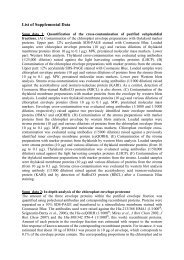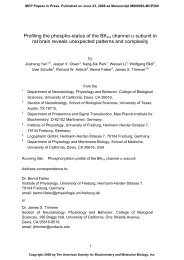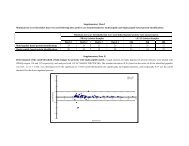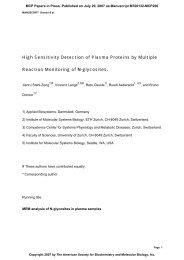Super-SILAC allows Classification of Diffuse Large B-cell ...
Super-SILAC allows Classification of Diffuse Large B-cell ...
Super-SILAC allows Classification of Diffuse Large B-cell ...
Create successful ePaper yourself
Turn your PDF publications into a flip-book with our unique Google optimized e-Paper software.
The above analysis required quantification <strong>of</strong> the proteins in every proteome measurement, which could<br />
exclude many interesting proteins, such as those exclusively expressed in only one subtype. We<br />
therefore employed imputation <strong>of</strong> missing values to make a larger subset <strong>of</strong> the proteome amenable to<br />
PCA analysis. We first filtered for at least 50% valid values (4991 proteins) and imputed the missing<br />
values. Incorporation <strong>of</strong> the information from these additional proteins led to an even stronger<br />
separation <strong>of</strong> the subtypes (Figure 4C). The GCB <strong>cell</strong> lines appear to cluster more tightly together,<br />
whereas the ABC <strong>cell</strong> lines U2932 and RIVA are somewhat separated from the other ABC <strong>cell</strong> lines. The<br />
loadings in the lower panel reveal additional known markers such as the <strong>cell</strong> surface markers CD44 for<br />
ABC-DLBCL (quantified exclusively in ABC) and CD27 for GCB-DLBCL (Figure 4D). The above analysis<br />
demonstrates that requiring less than 100% valid values and imputing missing values is a valid and<br />
robust strategy for segregation <strong>of</strong> subtype groups as well as for finding individual differentiators by<br />
proteomics.<br />
Category-based analysis <strong>of</strong> subtype differences – The above analyses were global and unbiased in that<br />
they considered the entire proteome. To determine if specific groups <strong>of</strong> proteins by themselves could<br />
differentiate the subtypes we extracted the proteins belonging to specific KEGG categories from the<br />
quantified proteome. We then performed PCA analysis on this subset as described above. Interestingly,<br />
the category ‘pathways in cancer’ (108 quantified proteins) was able to clearly separate the groups,<br />
albeit to a lesser degree than the full proteome (Figure 5A). The strongest loadings preferential for GCB<br />
in this category were p53, STAT5, STAT5B, and SPI1/PU.1 (Figure 5B). SPI1 has a major role in<br />
maintaining germinal center B <strong>cell</strong>s through repressing the expression <strong>of</strong> plasma <strong>cell</strong> transcription al<br />
regulators and thus blocking plasma <strong>cell</strong> differentiation (32). The strongest loadings preferential for ABC<br />
included the anti-apoptotic protein BCL2, overexpression <strong>of</strong> which is a known mechanism by which NF-<br />
κB driven tumors evade apoptosis. Surprisingly, the pro-apoptotic protein BID was also in this group.<br />
The loadings preferential for ABC include STAT3. It has been shown that NF-κB signaling in ABC induces<br />
[14]








